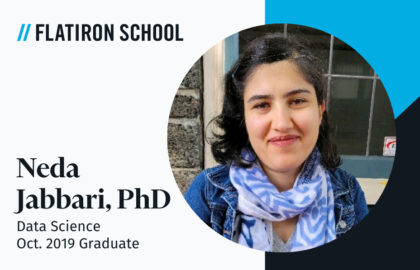
Key takeaways about Python
- Python is in demand across most industries thanks to its machine learning and data science applications.
- How long it takes to learn Python will depend on your time, dedication, and the study plan you choose.
- There are steps you can take to begin learning Python while you decide if a data science bootcamp is right for you.
Is Python worth learning in 2021?
Learning a programming language can be intimidating for those beginners without coding experience. The good news is that Python is the top data science language and the second most popular programming language. From data analysis to advanced machine learning algorithms, Python’s many advantages make it a central tool in data science and other key fields.
With such a wide range of applications, virtually every industry has a place for those with Python skills. If you’re thinking of entering data science, cybersecurity, or a non-technical field where programming will increase your career prospects, learning Python may be one of the best steps you can take for your career.
Why is Python in high demand?
Python is useful for so many tasks in tech careers. Data scientists use it to more efficiently sort data. Web developers use it to create large back-end databases. These skills are in demand — helping businesses create products and processes to run more efficiently and find key takeaways from large sets of data to streamline the business.
No matter how you plan to use Python, the quick answer comes down to flexibility and the vast data science libraries — such as Scikit-learn, Pandas, and NumPy — you can use to streamline your processes. First, let’s talk about flexibility.
Python is considered an extremely versatile language and its efficient programming structure is ideal for dealing with large amounts of data.
Python is good at predicting patterns, automating tasks, and crunching through the volumes of data necessary for data science and machine learning.
From working with data in tables to creating unsupervised machine learning algorithms, Python’s skill with data makes it popular no matter what other languages a company works in. That data strength means there’s almost always room for Python developers.
And because it’s relatively easy to learn, it can be a quick ‘add’ to a programmer or other employee’s skill set, enabling multiple team members to use and develop applications. This saves a firm from having to recruit specialized new talent and also results in a larger talent pool to draw from.
This popularity has led to the creation of a massive Python community, and with that comes libraries of code that developers can adapt freely for their own projects. There’s no shortage of sites offering free libraries and packages to tackle everything from basic automation to complex machine learning tasks. Some specialized library types, like pandas for data analysis, have become fundamentals in the community.
With all that free code, a company can develop and release applications at a fraction of the time required for other languages, and that means even more cost savings. Add up all the efficiency and talent, and you’re talking about a huge support infrastructure to keep Python central for a long time to come.
How long does it really take to learn Python?

In general, it takes 6-8 weeks to learn Python, and another 5 months to feel comfortable using Python after you’ve been practicing with it enough. How you decide to learn Python will impact how quickly you can learn it. For example, will you teach yourself? Will you take an online tutorial? Or will you go all in and sign up for a bootcamp?
A feature of Python that makes it easy to learn is the structure. The fact that it is an object-oriented language makes it easy to understand, and learning becomes easier as you can apply what you know about one package to another. For example, when it comes to machine learning models, you notice that the models all have the same framework, and this makes the results, metrics, and parameters easier to understand for each new classifier.
Python has an easy-to-understand syntax that makes it simple to apply what you know to new concepts in the language as you learn.
Can you teach yourself Python?
With all the free courses and libraries, it’s only sensible to ask if you can teach yourself Python. And the answer is usually yes – but with a condition.
Free Python lessons are widespread, and you can find some low-cost courses through sites that specialize in online learning. These courses will range from generic programming skills (using Python as an example) to expert-level deep dives into Python’s applications in machine learning and data science.
If you have a limited need for Python, such as basic skills or a one-time project, these free courses might be all you need. Likewise, if you are learning for personal interest and have no time constraints, you may find that these self-paced courses match your needs.
If you want to teach yourself Python, be sure to learn these topics:
- Python’s syntax
- Data types
- Data structures
- Determine which platforms you want to learn how to use
- General web development principles
- General coding process
But what if you are a professional seeking to learn Python for career advancement or a transition? You may find that structured training is worth the cost to ensure that your time is well spent.
For example, a data science bootcamp will teach you the skills you need to get a job in data science, including Python and other languages you need for this career.
Resources to teach yourself Python
1. Python tutorials
There are many free online tutorials to learn Python. Spend a few minutes on Google and you’ll be overwhelmed with the options.
2. Books
As with any other topic, you can learn a lot by taking a trip to your local library or hitting “add to cart” on Amazon.
Here are our top recommendations for books to teach yourself Python:
- Python Crash Course
- Learn Python 3 the Hard Way
- Head-First Python
- Think Python: How to Think Like a Computer Scientist
3. Online courses
Finally, if you want to go “all in” on learning Python, consider signing up for a data science bootcamp. Often, the curriculum will include an in-depth study of Python fundamentals and how to use it for data analysis.
How long does it take to learn Python in a data science bootcamp?

A data science bootcamp is one of the fastest but most thorough ways to learn true Python skills in a practical environment – but how long will it take? The answer depends on the provider and the structure.
Bootcamps can range from one to six months, and the hours can equate to a full-time job or part-time schooling.
For example, at Flatiron School, our Data Science bootcamp is available as both a 15-week program or flexible pacing options. For working professionals who need to fit learning into their already-busy schedule, there are 20, 40, and 60-week programs.
In other words, learning Python in a bootcamp will come down to the same factors we mentioned earlier: time, effort, and course structure.
But an immersive experience will offer a learning community, instructor guidance, and professional network that free courses cannot match…and you’ll emerge with a resume full of hands-on projects.
How can I Learn Python faster?
A structured bootcamp offers one of the quickest ways to learn practical Python skills in a career-oriented context. You’ll learn professional tools, gain a real-world career network, and a portfolio you can show prospective employers. But if you’re still thinking about taking that next step, there are a number of things you can do right now to begin learning Python.
First, you’ll want to set yourself up for success with an appropriate study environment.
Consider these good habits to build a structure that works for you:
- Pick a daily schedule and learning process and stick to them
- Turn off your phone, television, and other distractions
- Find a friend to keep you accountable…either a friend who wants to learn Python too or one who knows Python and can answer your questions
- Attend workshops in your area or online, or pick up popular books
- And most importantly, practice! Like any computer language, Python can only be learned well by doing it yourself.
What kind of tech job can I get with Python?
Demand for Python continues to grow across all industries. Data science has quickly become one of the fastest-growing job markets, and Python is the most popular tool in this field. Because it applies to almost any industry, this gives an advantage to mid-career professionals who have a solid record within their field and wish to add hard coding skills to their tool kit.
And because data science is a new player in the hiring scene, it also benefits from the updated hiring practices that have turned the four-year college degree from a must-have to an option and allowed people with diverse backgrounds to find their way into companies or fields that once had high barriers to entry.
Likewise, the nature of the work lends itself well to remote/work-from-home work models that are becoming increasingly popular, allowing you to craft your own lifestyle and live in an area that fits your economic and cultural needs.
Learning Python creates exciting new career opportunities no matter your age, background, or interests. We’ve seen our Data Science bootcamp alumni go on to rewarding careers in their fields, armed with the hard skills and confidence it takes to compete in a changing career environment.
Summary
Python is a critical skill in data science, machine learning, and cybersecurity. Professionals in every industry should consider how learning Python will open them up to new and exciting career opportunities – and remember that it’s never too late to get started — interested in learning more?
Try Free Prep Work, check out our course syllabus, or book a 10-minute chat with our team to discuss our programs.
Disclaimer: The information in this blog is current as of 5 August 2021. For updated information visit https://flatironschool.com/.




